Feature interactions enable decoding of sensorimotor transformations for goal-directed movement
- PMID: 24828640
- PMCID: PMC4099499
- DOI: 10.1523/JNEUROSCI.5173-13.2014
Feature interactions enable decoding of sensorimotor transformations for goal-directed movement
Abstract
Neurophysiology and neuroimaging evidence shows that the brain represents multiple environmental and body-related features to compute transformations from sensory input to motor output. However, it is unclear how these features interact during goal-directed movement. To investigate this issue, we examined the representations of sensory and motor features of human hand movements within the left-hemisphere motor network. In a rapid event-related fMRI design, we measured cortical activity as participants performed right-handed movements at the wrist, with either of two postures and two amplitudes, to move a cursor to targets at different locations. Using a multivoxel analysis technique with rigorous generalization tests, we reliably distinguished representations of task-related features (primarily target location, movement direction, and posture) in multiple regions. In particular, we identified an interaction between target location and movement direction in the superior parietal lobule, which may underlie a transformation from the location of the target in space to a movement vector. In addition, we found an influence of posture on primary motor, premotor, and parietal regions. Together, these results reveal the complex interactions between different sensory and motor features that drive the computation of sensorimotor transformations.
Keywords: MVPA; fMRI; sensorimotor transformations.
Copyright © 2014 the authors 0270-6474/14/346860-14$15.00/0.
Figures

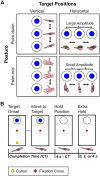

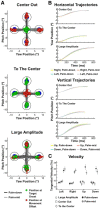
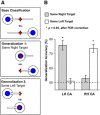
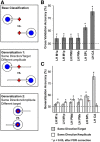
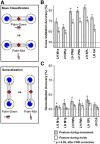

Similar articles
-
Brain mechanisms for preparing increasingly complex sensory to motor transformations.Neuroimage. 2004 Nov;23(3):1100-11. doi: 10.1016/j.neuroimage.2004.07.043. Neuroimage. 2004. PMID: 15528110 Clinical Trial.
-
Functional activation in parieto-premotor and visual areas dependent on congruency between hand movement and visual stimuli during motor-visual priming.Neuroimage. 2007 Jan 1;34(1):290-9. doi: 10.1016/j.neuroimage.2006.08.043. Epub 2006 Oct 23. Neuroimage. 2007. PMID: 17056279
-
Differentiating intended sensory outcome from underlying motor actions in the human brain.J Neurosci. 2014 Nov 12;34(46):15446-54. doi: 10.1523/JNEUROSCI.5435-13.2014. J Neurosci. 2014. PMID: 25392511 Free PMC article.
-
Visually-guided correction of hand reaching movements: The neurophysiological bases in the cerebral cortex.Vision Res. 2015 May;110(Pt B):244-56. doi: 10.1016/j.visres.2014.09.009. Epub 2014 Sep 28. Vision Res. 2015. PMID: 25264945 Review.
-
The posterior parietal cortex: sensorimotor interface for the planning and online control of visually guided movements.Neuropsychologia. 2006;44(13):2594-606. doi: 10.1016/j.neuropsychologia.2005.10.011. Epub 2005 Nov 21. Neuropsychologia. 2006. PMID: 16300804 Review.
Cited by
-
Perceptual-Cognitive Integration for Goal-Directed Action in Naturalistic Environments.J Neurosci. 2023 Nov 8;43(45):7511-7522. doi: 10.1523/JNEUROSCI.1373-23.2023. J Neurosci. 2023. PMID: 37940592 Free PMC article. Review.
-
Primary motor cortical activity during unimanual movements with increasing demand on precision.J Neurophysiol. 2020 Sep 1;124(3):728-739. doi: 10.1152/jn.00546.2019. Epub 2020 Jul 29. J Neurophysiol. 2020. PMID: 32727264 Free PMC article.
-
Enhanced processing of aversive stimuli on embodied artificial limbs by the human amygdala.Sci Rep. 2022 Apr 6;12(1):5778. doi: 10.1038/s41598-022-09603-0. Sci Rep. 2022. PMID: 35388047 Free PMC article.
-
Flexible Reference Frames for Grasp Planning in Human Parietofrontal Cortex.eNeuro. 2015 Jun 24;2(3):ENEURO.0008-15.2015. doi: 10.1523/ENEURO.0008-15.2015. eCollection 2015 May-Jun. eNeuro. 2015. PMID: 26464989 Free PMC article.
-
Multivariate fMRI Approaches to Flexible Sensorimotor Maps in Parietal Cortex.J Neurosci. 2015 Aug 26;35(34):11763-5. doi: 10.1523/JNEUROSCI.2307-15.2015. J Neurosci. 2015. PMID: 26311760 Free PMC article. No abstract available.
References
-
- Benjamini Y, Yekutieli D. The control of the false discovery rate in multiple testing under dependency. The Annals of Statistics. 2001;29:919–1188.
Publication types
MeSH terms
Grants and funding
LinkOut - more resources
Full Text Sources
Other Literature Sources
